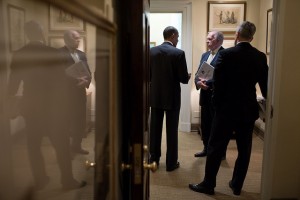Some Torture Facts
At the request of some on Twitter, I’m bringing together a Twitter rant of some facts on torture here.
1) Contrary to popular belief, torture was not authorized primarily by the OLC memos John Yoo wrote. It was first authorized by the September 17, 2001 Memorandum of Notification (that is, a Presidential Finding) crafted by Cofer Black. See details on the structure and intent of that Finding here. While the Intelligence Committees were briefed on that Finding, even Gang of Four members were not told that the Finding authorized torture or that the torture had been authorized by that Finding until 2004.
2) That means torture was authorized by the same Finding that authorized drone killing, heavily subsidizing the intelligence services of countries like Jordan and Egypt, cooperating with Syria and Libya, and the training of Afghan special forces (the last detail is part of why David Passaro wanted the Finding for his defense against abuse charges — because he had been directly authorized to kill terror suspects by the President as part of his role in training Afghan special forces).
3) Torture started by proxy (though with Americans present) at least as early as February 2002 and first-hand by April 2002, months before the August 2002 memos. During this period, the torturers were operating with close White House involvement.
4) Something happened — probably Ali Soufan’s concerns about seeing a coffin to be used with Abu Zubaydah — that led CIA to ask for more formal legal protection, which is why they got the OLC memos. CIA asked for, but never got approved, the mock burial that may have elicited their concern.
5) According to the OPR report, when CIA wrote up its own internal guidance, it did not rely on the August 1, 2002 techniques memo, but rather a July 13, 2002 fax that John Yoo had written that was more vague, which also happened to be written on the day Michael Chertoff refused to give advance declination on torture prosecutions.
6) Even after CIA got the August 1, 2002 memo, they did not adhere to it. When they got into trouble — such as when they froze Gul Rahman to death after hosing him down — they went to John Yoo and had him freelance another document, the Legal Principles, which pretend-authorized these techniques. Jack Goldsmith would later deem those Principles not an OLC product.
7) During both the August 1, 2002 and May 2005 OLC memo writing processes, CIA lied to DOJ (or provided false documentation) about what they had done and when they had done it. This was done, in part, to authorize the things Yoo had pretend-authorized in the Legal Principles.
8) In late 2002, then SSCI Chair Bob Graham made initial efforts to conduct oversight over torture (asking, for example, to send a staffer to observe interrogations). CIA got Pat Roberts, who became Chair in 2003, to quash these efforts, though even he claims CIA lied about how he did so.
9) CIA also lied, for years, to Congress. Here are some details of the lies told before 2004. Even after CIA briefed Congress in 2006, they kept lying. Here is Michael Hayden lying to Congress in 2007
10) We do know that some people in the White House were not fully briefed (and probably provided misleading information, particularly as to what CIA got from torture). But we also know that CIA withheld and/or stole back documents implicating the White House. So while it is true that CIA lied to the White House, it is also true that SSCI will not present the full extent of White House (read, David Addington’s) personal, sometimes daily, involvement in the torture.
11) The torturers are absolutely right to be pissed that these documents were withheld, basically hanging them out to dry while protecting Bush, Cheney, and Addington (and people like Tim Flanigan).
12) Obama’s role in covering up the Bush White House’s role in torture has received far too little attention. But Obama’s White House actually successfully intervened to reverse Judge Alvin Hellerstein’s attempt to release to ACLU a short phrase making it clear torture was done pursuant to a Presidential Finding. So while Obama was happy to have CIA’s role in torture exposed, he went to great lengths, both with that FOIA, with criminal discovery, and with the Torture Report, to hide how deeply implicated the Office of the President was in torture.
Bonus 13) John Brennan has admitted to using information from the torture program in declarations he wrote for the FISA Court. This means that information derived from torture was used to scare Colleen Kollar-Kotelly into approving the Internet dragnet in 2004.
